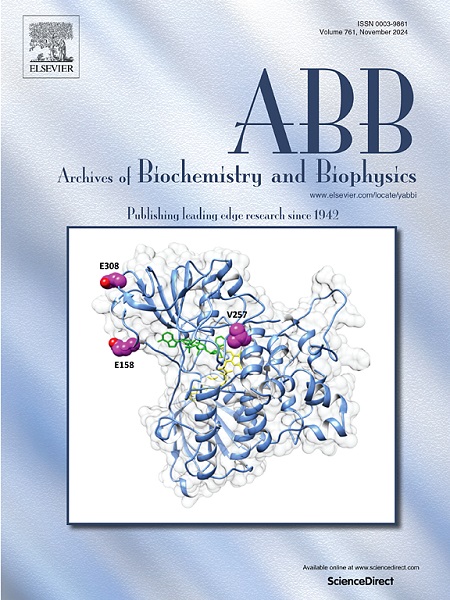AMPK-YAP信号通路介导的线粒体动力学和线粒体自噬参与水飞蓟宾对高糖条件下HaCaT细胞的保护作用
IF 3.8
3区 生物学
Q2 BIOCHEMISTRY & MOLECULAR BIOLOGY
引用次数: 0
摘要
紫外线照射和糖尿病会导致皮肤损伤。然而,在糖尿病领域很少对紫外线照射进行研究。Silibinin 对许多疾病都有积极的治疗作用。然而,在高糖(HG)条件下,水飞蓟宾对紫外线诱导的表皮细胞损伤的抑制作用却鲜有研究。因此,本研究探讨了西利宾在减轻 UVB 诱导的表皮细胞凋亡方面的保护作用及其机制。丝利宾减轻了 HG 和 UVB 对人永生角质形成细胞(HaCaT)线粒体凋亡和促炎因子产生的影响。同时,丝利宾还能逆转 UVB 诱导的 HG 培养 HaCaT 细胞裂变/融合失衡。此外,在HG条件下,暴露于UVB会增加ROS水平并降低HaCaT细胞的有丝分裂;然而,这些影响随后会被西利宾处理所逆转。AMPK 通过负向调节 YAP 来维持能量平衡。Silibinin 提高了经 HG 和 UVB 处理的 HaCaT 细胞中 p-AMPK 和细胞质 YAP 蛋白的水平。此外,丝利宾还改善了线粒体动力学功能障碍,提高了有丝分裂吞噬水平、细胞活力和细胞质 YAP 蛋白的表达,而应用 AMPK 抑制剂(化合物 C)可逆转这些影响。总之,西利宾通过AMPK-YAP信号通路调节线粒体动力学和有丝分裂,在HG条件下保护表皮细胞免受UVB诱导的凋亡。本文章由计算机程序翻译,如有差异,请以英文原文为准。
AMPK-YAP signaling pathway-mediated mitochondrial dynamics and mitophagy participate in the protective effect of silibinin on HaCaT cells under high glucose conditions
UVB irradiation and diabetes lead to skin injury. However, UVB irradiation has rarely been studied in the field of diabetes. Silibinin has a positive therapeutic effect on many diseases. Nevertheless, the inhibitory effects of silibinin on UVB-induced damage to epidermal cells under high glucose (HG) conditions have been infrequently investigated. Consequently, this study examined the protective efficacy and mechanisms of silibinin in mitigating UVB-induced apoptosis in epidermal cells cultured under HG conditions. The effects of combination of HG and UVB on mitochondrial apoptosis and pro-inflammatory factors production in human immortalized keratinocytes (HaCaT) were mitigated by silibinin. Meantime, silibinin reversed the UVB-induced imbalance of fission/fusion in HG-cultured HaCaT cells. Furthermore, UVB exposure increased ROS levels and reduced mitophagy in HaCaT cells under HG conditions; however, these effects were subsequently reversed by silibinin treatment. AMPK preserves energy balance by negatively regulating YAP. Silibinin increased the levels of p-AMPK and cytoplasmic YAP proteins in HaCaT cells subjected to HG and UVB treatment. Moreover, silibinin improved the dysfunction of mitochondrial dynamics, increased mitophagy levels, the viability and the expression of cytoplasmic YAP protein, and these effects were reversed via the application of an AMPK inhibitor (compound C). In summary, silibinin safeguarded epidermal cells from UVB-induced apoptosis under HG conditions by modulating mitochondrial dynamics and mitophagy through the AMPK-YAP signaling pathway.
求助全文
通过发布文献求助,成功后即可免费获取论文全文。
去求助
来源期刊

Archives of biochemistry and biophysics
生物-生化与分子生物学
CiteScore
7.40
自引率
0.00%
发文量
245
审稿时长
26 days
期刊介绍:
Archives of Biochemistry and Biophysics publishes quality original articles and reviews in the developing areas of biochemistry and biophysics.
Research Areas Include:
• Enzyme and protein structure, function, regulation. Folding, turnover, and post-translational processing
• Biological oxidations, free radical reactions, redox signaling, oxygenases, P450 reactions
• Signal transduction, receptors, membrane transport, intracellular signals. Cellular and integrated metabolism.
 求助内容:
求助内容: 应助结果提醒方式:
应助结果提醒方式:


